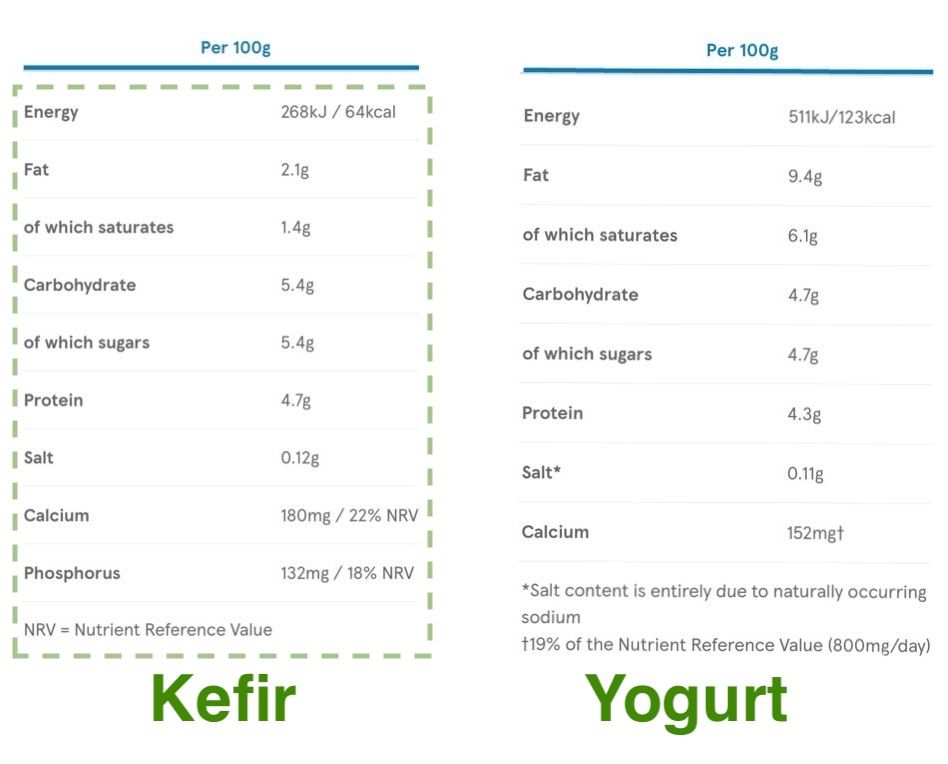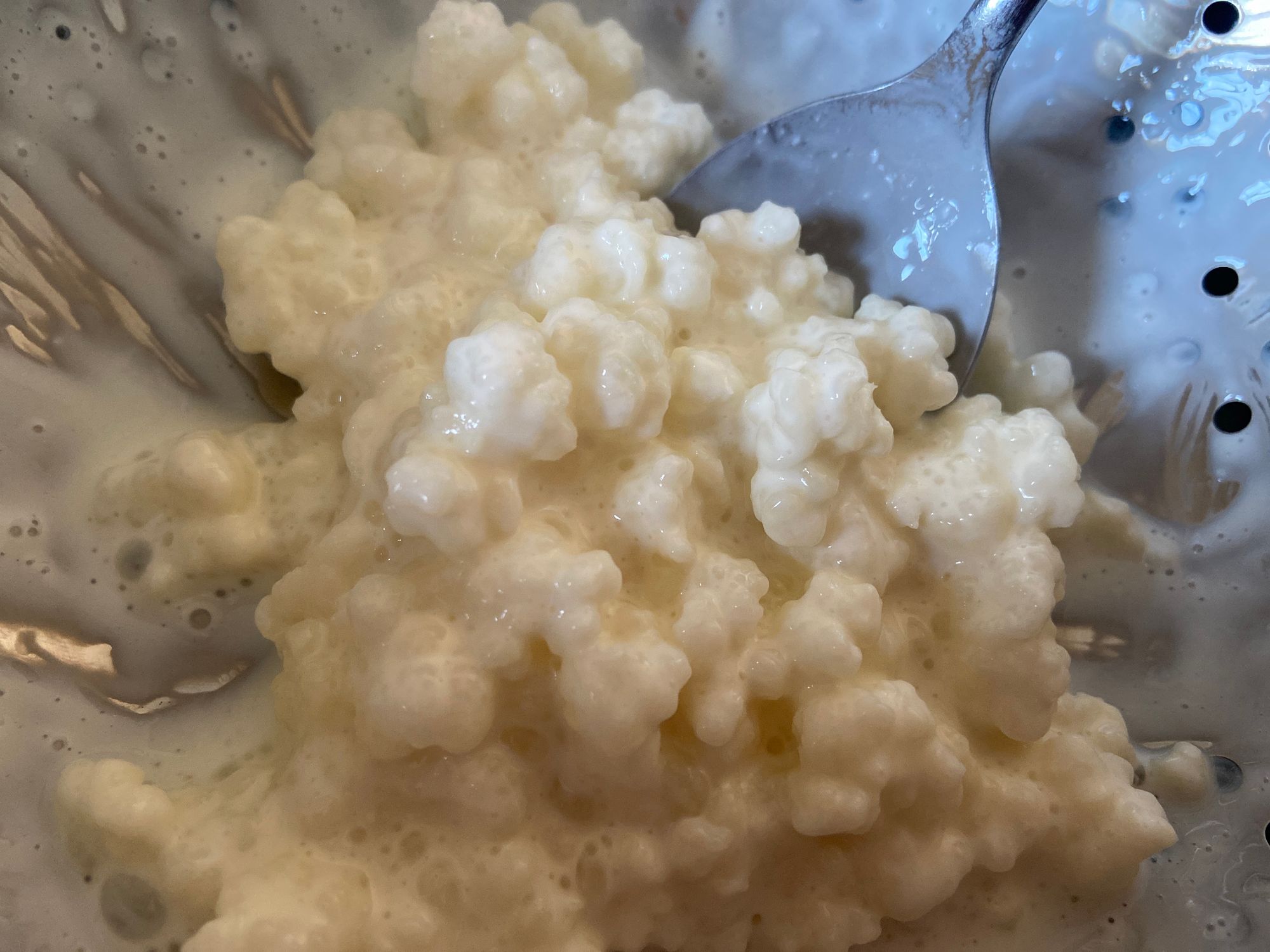Saturday Blueprint on the two best homemade health foods
Two potent health foods - kefir and bone broth - that you can make at home cheaply and quickly

Fermentation may have been a greater discovery than fire. — David Wallace
This week I’ve got a couple of great recipes for you. Both are superfoods and yet are cheap and easy to make at home. Kefir and bone broth.
🥛 Kefir benefits
Fermentation is an ancient practice of preserving and improving foods. Kefir is a fermented milk drink that has been traditionally consumed in Eastern Europe and Asia for centuries. It is made by fermenting milk with kefir ‘grains’, which are a combination of bacteria and yeast. The kefir grains also go by the name SCOBY, standing for symbiotic culture of bacteria and yeast.
Kefir grains are small, gelatinous, and cauliflower-shaped structures. The grains are typically white in color and have a slightly sour smell. You can eat them - I typically do when they start to over-proliferate and I need to reduce the population.
The kefir grains ferment the lactose (a milk sugar) in milk, which produces the characteristic tangy taste and very slight fizziness of kefir, which is similar in taste to yogurt, just less thick.
The strategy with using kefir grains to ferment milk is essentially that you outsource some of the digestion and detoxification to bacteria. The fermentation improves the digestability of the milk proteins and milk sugars.
There are a number of benefits to fermenting foods, of which kefir is one example, and I drink kefir daily.
In the centuries before refrigeration there was the practical benefit that fermenting food increased the shelf life. But there are also a number of health benefits, which I’ll outline, so even though we now have our fridges and next day grocery delivery delivery and certainly have no need to ferment milk for preservation we can still get some great benefits and have a tasty yogurt-like drink.
Here are five potential benefits of kefir:
- Improved digestion: Kefir contains probiotics, which are beneficial bacteria that can help improve the balance of the gut microbiome. This can lead to better digestion, fewer digestive problems like bloating and constipation, and even an improved immune system due to the probiotics.
- Potential anti-inflammatory effects: Some research suggests that the probiotics and other bioactive compounds in kefir may have anti-inflammatory effects. This could be beneficial for people with conditions like inflammatory bowel disease, arthritis, and other inflammatory conditions.
- Potential cardiovascular benefits: Some studies have found that kefir consumption may be associated with lower blood pressure and improved cholesterol levels, which could be beneficial for heart health.
- Nutrient-rich: Kefir is a good source of several nutrients, including protein, calcium, and B vitamins. It is also a good source of Vitamin A (which has antioxidant properties and is used to make immune cells) and Phosphorus (which works with calcium to provide structure to your bones and teeth).
- Improved blood sugar: predigestion of the milk sugars by the bacteria means you get a much lower insulin response than if you were drinking regular milk, and you get a perfect dose of probiotics. The low lactose content makes it a good option for people who are lactose sensitive.
Kefir is also easy and practical to make at home (as the recipe below will show). The kefir grains can be used repeatedly to make endless batches of kefir. They can also be used to ferment other types of liquids, such as coconut milk, to make non-dairy kefir. I’ve never tried this but you could experiment with that too.
All the fuss around fermented foods rests on the perceived importance of the gut microbiome. And in researching this I’ve found out that the gut microbiome is truly quite remarkable.
Let’s start with what it is. The gut microbiome is the diverse community of microorganisms that live in the digestive tract of humans and other animals. The microbiome is composed of a vast array of bacteria, viruses, fungi, and other microbes that play a crucial role in the digestive process and in maintaining the overall health of the host organism.
Now I don’t like to think of myself as ‘the host organism’ but that’s exactly what this relationship is - it’s a symbiotic relationship where our bodily cells and processes work with the microorganisms in the gut in a win:win arrangement.
Incredibly, the gut microbiome contains over 100 trillion bacteria from hundreds of different species, which is more than 10 times the number of cells in the human body! In fact, the genetic material of the bacteria in the gut microbiome outnumbers the human genes by a factor of 100 to 1. This means that we are more bacteria than we are human, and just from a numbers point of view you can start to see that this thing we call the gut micro biome might be pretty important.
It’s a fledging area of scientific research so the exact mechanisms of the gut microbiome are not known, although the benefits certainly are. One of my favourite studies took twins - one of which was fat and the other one normal - and extracted a sample of their gut microbiome. This was implanted in mice of healthy weight and the mice that got the ‘fat’ microbiome became fat themselves. The study proved the transmissibility of obesity via the gut microbiome. It also infers the opposite: that you can reverse obesity by altering the microbiome.
The gut microbiome is also an important source of our bodily immunity, playing a significant role in reducing inflammation.
Mounting research suggests that our intestinal microbiome has a profound influence on digestive and immune function, inflammation control, mood stability and cognitive function (e.g., 90 percent of the “feel good” neurotransmitter serotonin is produced in the gut), insulin sensitivity and fat metabolism, improved thyroid function, improved sleep, and much more.
The gut microbiome plays a crucial role in our overall health and well-being. It’s not just about digestion. Your body weight and immune function and brain function are also profoundly and intimately affected by these trillions of microorganisms along for the ride.
Dr. Cate Shanahan, author of Deep Nutrition, has four pillars of healthy nutrition. These are:
- Meat on the bone (which includes bone broth - more in this below)
- Organ meats
- Fresh foods
- Fermented foods
She understand the importance of fermented foods such that they get their own pillar. They should be part of everyone’s diet, and kefir is a great place to start.
In comparison to yogurt which you might be more familiar with, kefir is lower is fat but similar in protein, as shown below.

🗒️ Kefir recipe
The ingredients for kefir are milk and kefir grains. The kefir grains are reused each time, so once you’ve bought some to get started you won’t need to buy these again.
For equipment you need a glass jar - a 2 litre capacity works well. Plus a sieve for straining out the kefir grains. For those familiar with yogurt making you don’t need any heating or cooling or specific temperatures. You just leave the milk plus kefir grains in the jar on the counter at room temperature.
The recipe is so simple and foolproof - every other day just strain the grains from the kefir. Put the strained kefir in the fridge to drink later. Put the kefir grains back in the jar and add some new milk. I do about 1 litre of milk at a time. Leave on the counter for two days. Repeat.
I clean out the jar maybe once a week or two - I’ve found I don’t need to clean it each batch.
It’s much cheaper than store bought kefir, and takes seconds. Give it a try!

The picture shows the kefir ‘grains’ which are actually these fascinating symbiotic cultures of bacteria and yeast. They are rubbery and it’s these grains that ferment the milk into kefir.
🦴 Bone broth benefits
Bone broth is made by simmering bones and connective tissue for an extended period of time, which releases many nutrients and compounds into the broth. This slow cooking process also results in a rich, flavorful broth that can be used as a base for soups, stews, and other dishes.
Bone broth is a traditional remedy for a number of ailments - homemade chicken soup is a classic cold and flu remedy and is mostly comprised of chicken stock, which is another name for chicken bone broth.
It has also been used historically for ailments that affect connective tissues such as the gastrointestinal tract, the joints, the skin, the lungs snd the muscles.
We know that bone broth has been consumed for centuries in many different cultures as a traditional remedy for a variety of these health conditions. I’m fascinated by foods and drinks which are also medicines. Is it a drink or is it a medicine? It’s both!
In Chinese medicine for example, bone broth has been used for thousands of years to support digestive health, boost the immune system, and promote healing. In Western culture, bone broth has also been used historically as a remedy for digestive problems, joint pain, and other ailments.
Now with modern scientific research there are a number of properties of bone broth that have been linked to potential health benefits.
For example, bone broth is rich in minerals like calcium, magnesium, and phosphorus, which are important for bone health. It also contains collagen, a protein that is essential for healthy skin, hair, and nails.
Let’s explore the nutrients in bone broth and their benefits.
Firstly, what’s in it? Well bone broth is a good source of several important nutrients, including calcium, magnesium, phosphorus, and potassium. It is also a good source of protein and its precursor amino acids, which is important for building and repairing tissues in the body. The nutrients gelatin, collagen, glucosamine, and chondroitin are also found in bone broth and come from the connective tissue on the bones and are typically hard to come by in the diet otherwise.
Let’s look at the key nutrients in turn:
Collagen
Collagen is a protein and interestingly 25% of the protein in your body is collagen. It’s great for hair, nails, skin and joints. Consuming bone broth may help improve the appearance and texture of these tissues.
Collagen also is believed to support the integrity of your gut lining with a highly touted “heal and seal” effect. Collagen is rich in amino acids like proline and glycine, which can promote good sleep by acting as inhibitory neurotransmitters.
Dietary or supplemental collagen has a heliotropic effect in your body—it travels into the areas where it is most needed, such as a brittle joint or tendon.
Gelatin
Gelatin has soothing and healing gut health benefits. It may also help improve the balance of gut bacteria, which can have a positive effect on overall health.
Amino acids
Amino acids are the building blocks of protein. Bone broth is a rich food in amino acids with this gives anti-inflammatory properties. Bone broth reduces the damage to organs and tissues because it is capable of modulating the immune response by decreasing the expression of pro-inflammatory cytokines, and stimulating the expression of anti-inflammatory cytokines. [2]
This is the anti-ageing tonic then, since ageing is accompanied by greater levels of molecules called cytokines that promote inflammation. Reduce cytokines and you'll improve ageing.
Glycine
Glycine is one of the amino acids. A few studies have shown benefits in sleep quality. but the main benefit is in reducing the blood glucose response when eating carbohydrates.
Glycosaminoglycans
There are other compounds in broth that gel besides collagen. The ground substance of cartilage is made of proteoglycans, huge sugar and protein molecules. Attached to a core protein are long strands of glycosaminoglycans (GAGs) also called mucopolysaccharides. These structures are naturally jellylike. The GAGs in cartilage are hyaluronic acid, chondroitin sulfate and to a lesser degree, keratin sulfate. Hyaluronic acid forms a central strand to which chondroitin and keratin sulfate bond.
GAG-based drugs are becoming increasingly relevant to treat cancer. [3]
Glycosaminoglycans regulate the biomechanical properties of vessels, tissue assembly and repair in vascular lesions. [4]
Chondroitin sulfate
Chondroitin Sulfate is a jellylike substance, now famous as a supplement for joint pain associated with osteoarthritis. It functions to support and provide adhesiveness. It lines blood vessels and plays a role in lowering atherosclerosis, cholesterol and heart attacks.
Calcium
Calcium is a mineral and is important for bone and teeth health. It is one of the minerals in the the matrix of these hard structures. Calcium is necessary for the transmission of nerve impulses, which allows the body to communicate between the brain and other parts of the body.
In addition, obtaining adequate amounts of calcium is associated with reduced risk of osteoporosis, colon polyps, colorectal cancer, calcium oxalate kidney stones, and can help you control hypertension and cholesterol [5].
As well as the science it just plain tastes lovely and is comforting to drink, and if the Lindy effect counts for anything then it’s bone broth. It’s been used for centuries and will continue to be used for many centuries to come. So give a try. Cheers!
🗒️ Bone broth recipe
The recipe is simple:
- Assorted bones. Marrow bones are particularly good.
- 3 Tbsp apple cider vinegar - for acidity to help get the most nutrients from the bones
- 1 Tbsp whole peppercorns
- Pinch of salt (most of the seasoning is done after the boiling)
- Two bay leaves
- Water to cover (about 6 litres for my InstantPot)
- Optional: any carrots, celery, onions etc. including peelings
Put everything into a pot and simmer on the stove all day, or, if you’ve got an InstantPot like I do, you can cook on high pressure for 1 hour or more. I often cook on high pressure for 4 hours just to eek on the benefit out of those bones.
Strain it and let it cook in the fridge. You can if you wish skim off any solidified fat once it’s cooled.
You can use the broth in recipes - for example making a gravy or soup - or I like to just heat it and drink it, seasoning to taste with salt. I have two cups of bone broth a day.
Other fermented foods to try
You could also try sourdough - this is easy and tastes great but is too much refined grains for me.
Or what about kimchi or sauerkraut - fermented cabbage - I’ve tried this but failed in the past so now I do enjoy eating but I just buy store bought versions.
References
- Siebecker, Allison. Traditional bone broth in modern health and disease. Diss. NCNM, 2004.
APA - Mar-Solís LM, Soto-Domínguez A, Rodríguez-Tovar LE, Rodríguez-Rocha H, García-García A, Aguirre-Arzola VE, Zamora-Ávila DE, Garza-Arredondo AJ, Castillo-Velázquez U. Analysis of the Anti-Inflammatory Capacity of Bone Broth in a Murine Model of Ulcerative Colitis. Medicina. 2021; 57(11):1138. https://doi.org/10.3390/medicina57111138
- Yip, George W. et al. “Therapeutic value of glycosaminoglycans in cancer.” Molecular Cancer Therapeutics 5 (2006): 2139 - 2148.
- Maksimenko, Alexander V.. “Effects of glycosaminoglycans in vascular events.” Pharmaceutical Chemistry Journal 42 (2008): 553-563.
- Calcium. Reactions Weekly 1885, 124 (2021). https://doi.org/10.1007/s40278-021-06883-6
About the Saturday Blueprint
The Saturday Blueprint is a weekly newsletter every Saturday on health, vitality and philosophy by Nick Stevens.
Join the Facebook page to interact with the community.